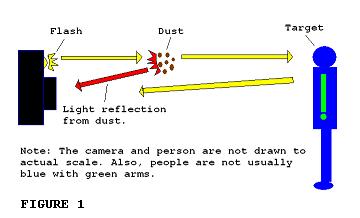OPS Central - Going into Or-bit
Going Into Orb-It
By Kevin Woodrow
SUBJECT: ORB EDUCATION
I want to start this week’s installment off with an apology. From depths of my heart, I am truly sorry for the cheesy title I have given this article. It is, by far, the cheesiest so yet. And, furthermore, there is no excuse for it. Cheesiness such as this will not happen again… at least… not until next week.
Although the title is bad, hopefully, the content will not be. This week’s topic is a photographic phenomena known simply as an “orb”. If you’ve followed any type of paranormal / ghost hunting show or program, I’m sure you’ve heard of this spherical mystery. Most people assume that an orb is automatically defined as the soul of a deceased person. However, that’s not entirely true. The confusion begins with the use, or rather common misuse, of the word itself.
The term “orb” was coined in 1994 by Dave Oester of the International Ghost Hunters Society. An orb, in the way that the term was originally meant to be used, is any circular anomaly that appears on a photograph. So, therefore, saying something is an “orb” does not mean that it is actually something paranormal in origin. The trick is actually determining what created each particular orb. And, with that, comes the sometimes difficult part. An orb can be created by many different things that are completely rational. These types of orbs are called “Natural Orbs”.
Natural orbs can be caused by dust, rain droplets, snow flakes, pollen, spores, and basically any small particle that floats in the air. This type of orb appears when there are particles in the air between your camera and your photographic target. As the flash of your camera goes off, light from that flash can reflect off of those tiny particles - thus, creating many of the natural orbs that you see in pictures. A visual example of this process is found in Figure 1.
The type of orb that most people associate the term with, however, is what we refer to as a “Spirit Orb” or “Ghost Orb”. These orbs are often much brighter than “Naturals”, and sometimes appear to be almost three-dimensional. It seems almost as if they have their own source of light. These are believed by many investigators to be the souls of the deceased - spirits of energy complete with the person’s intelligence, emotion, personality, etc..
These “Spirit Orbs” are believed to be caught on film, yet not seen by the naked eye, because they are only detected by infrared light. And, we normally can not see infrared light. However, a digital camera picks this light up when taking a picture.
To experiment with this, if you have a digital camera, you can take the remote control to your TV. Point it directly at your camera. Then, while looking through the view-finder of the camera, press a button on the remote. You should be able to see a small light through the view-finder that you can not see with the naked eye. That’s because it’s infrared light. That’s the type of light that many paranormal investigators believe that most “Spirit Orbs” and ghosts, for that matter, are seen with. This is also why OPS uses infrared video cameras.
However, many people believe that this is not true at all. This is part of why we investigate, to attempt to help find a truth to the many questions that these phenomena pose.
What does the OPS Team do to help determine what is a “Natural” and what is a “Spirit”? That is a wonderful question, and I’m glad I asked myself that. Okay, now I’m talking to myself…
The best possible way of deciding what could possibly be paranormal is by purposefully taking many photos of those things that create “Natural Orbs”. The more photographic samples we have, the better. By keeping records of what “Naturals” look like, we can then compare new orb photos to them in order to help to determine each anomaly’s origin. If we come across something that we can’t seem to match up with any of our samples, then it could very well be caused by something unknown.
We, here at OPS, seem to question ourselves every time we capture something on still photos or video footage. And, that is a good thing. We, ourselves, have become our biggest critics. If we capture something out of the ordinary, we always seem to attempt to recreate it - to try to see if it was something we did accidentally. We’re all very open-minded, but we want to be as sure as possible that we truly have something paranormal before we claim that we do.
It all comes down to not assuming we have something “special“. We have to remain level-headed and assume we have something practical until we can’t find a practical solution. Basically, it works like a process of elimination.
I sincerely hope this has helped open your minds up to what the word “orb” actually means, and the many different ways one can be created - both the strange and the not-so-strange ways. And I hope that this has given you some insight on how we handle orb photos when we capture them. Remember, an orb can be whatever you truly want it to be. If you want it to be a spirit, to you, it will be a spirit. To us, we just want it to be whatever it actually is.
Until next time,
-Kevin-
